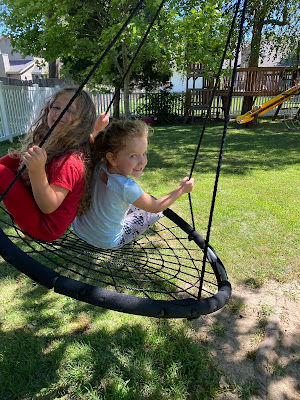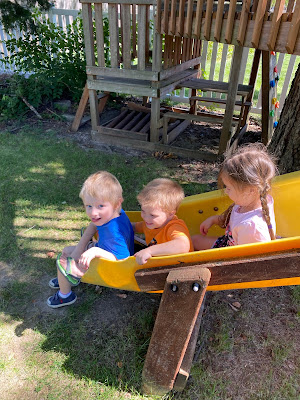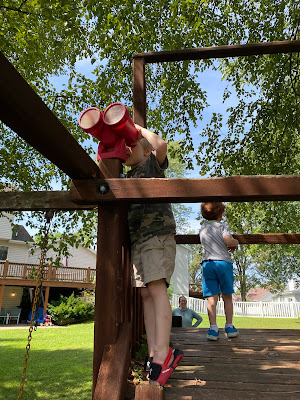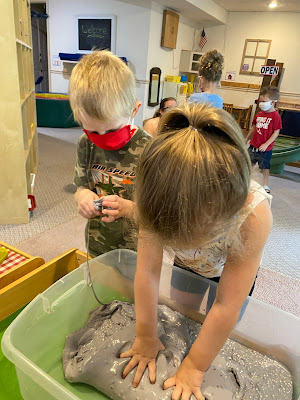Thursday, September 9, 2021
Tuesday, August 24, 2021
2021-2022 Calendar
Theme- all about me / introduce values / oceans, explore-seashells and 5 senses, letters in our names
August
26- my preschool/routines
31- my body/patience
September
2- my name/trustworthiness
7- my 5 senses/respect
9- my family/helpfulness
14- my feelings/gratitude
16- my friends/kindness
21- my talents/curiosity
23- my home/review
Theme-Fall Farms / Halloween, explore- apples, vegetables, pumpkins, nuts, and leaves
28- apples, letter A
30- farm animals, a
October
5- vegetable gardens, letter B
7- pumpkins, b
12- owls, letter C
14- bats, c
19- squirrels and nuts, letter D
21- leaves, d
Fall Break
Theme- A Forest Thanksgiving, explore- trees, leaves, and forests
November
4- bugs, letter review
9- forest animals, letter E
11- bears, e
16- turkeys, letter F
18- first thanksgiving, f
23- gratitude, letter review
Happy Thanksgiving
Theme- Christmas, explore- evergreen trees
30- reindeer, letter G
December
2- evergreen trees, g
7- 5 senses of Christmas, letter H
9- gingerbread man, h
14- helpful elves, letter I
16- caroling- i
21- Giving
Christmas break
Theme- winter / polar animals, explore- magnets
January
4- snow, letter J
6- snowmen, j
11- quilts, letter K
13- mittens, k
18- penguins, letter L
20- polar bears, l
Theme- community helpers, explore- rocks
25- construction workers, letter M
27- mechanics and drivers (vehicles), m
February
1- doctors, letter N
3- dentists and grocers (food), n
8- mail carriers, letter O
10- Valentine’s Day, o
15- firefighters, letter P
17- police officers (safety), p
22- scientists (space), letter Q
24- scientists (dinosaurs), q
March
1- zookeepers, letter R
3- veterinarians, r
Theme- weather, explore- water
8- rain, letter S
10- sun and rainbows, s
15- wind, letter T
17- St Patrick’s Day, t
Spring Break
Theme- Spring at the Pond, explore- flowers and birds
29- seeds, letter U
31- fruit, u
April
Election Day
7- teddy bear picnic, letter review
12- rabbits, letter V
14- Easter, v
19- frogs, letter W
21- ducks, w
26- bees, letter X
28- butterflies, x
May
3- flowers, letter Y
5- Mother’s Day, y
10- birds, letter Z
12- trees and nests, z
Theme- A Fairytale Farewell
17- favorite fairytales
19- favorite stories
24- graduation
Tuesday, May 18, 2021
Social and Emotional learning (Self Advocacy and Problem Solving)
My preschool social/emotional learning philosophy or “the nitty- gritty how-to’s of an effective way to teach social/emotional skills”
I believe children need to learn, and be given the time and space to practice:
1. Appropriately advocating for their wants and needs (example: if another child is doing something they don’t like they learn to talk to that child directly and appropriately- adults are available to help them through the *process but hand more of the responsibilities over to them with time).
2. Listening to the wants and needs of others and responding
3. Problem solving how to compromise and work together
4. Making mistakes and how to recover from them
I believe children need to learn and be given the time and space to practice these things in an environment that is:
1. Positive, supportive, and loving
2. Stimulating- filled with plenty of fun activities that will foster brain growth and learning
I believe when these things occur, and children are taught and modeled values such as being kind, respectful, helpful, grateful, trustworthy, curious, and patient, then the children will be able to live these values easier because they have gained:
1. Emotional generosity- when they are provided with a lot of emotional generosity; patience, love, service, forgiveness, respect, trust, understanding, etc, they are not emotionally drained and are able to treat others with those same gifts
2. Flexibility- when they feel like they know how to have control over their circumstances (they have been taught empowering self advocacy and problem solving skills), they are able to be more flexible- instead of being rigid because they think that is their only way to feel like they have control
3. Self confidence- they feel valued and capable
4. Compassion- they see and learn the value of other people as they listen to them and work together with them
I believe a proper (puts a lot of focus on what’s most important) preschool environment (part-time is plenty) can be a valuable and helpful part of the process of teaching these things to children because:
1. It is the perfect age (their understanding is developed enough) and environment (being with a diverse group of similar aged peers) to practice these skills.
2. Teachers can focus their time and energy on patiently teaching these skills because they don’t have to juggle all the parenting balls and emotions at the same time (it can be taught at home with siblings successfully also).
3. As children gain in their abilities, parents and teachers can work together if needed to help carryover their skills to home and other settings (as parents don’t often get to witness their children in an environment with many similar aged peers, it’s helpful to share specific strategies that have been taught and have worked for their child that can then be applied to different situations- it’s often helpful for parents to have the same vocabulary, or ideas, to trigger for the child what they are learning).
*the process
1. Get the person who you want to talk to’s attention (usually just saying their name or adding “I need to tell you something”), and then wait for them to give their attention. If they won’t give you their attention you may ask an adult for help.
2. Tell them the problem/want/need and what you want/need from them (I want a turn with that toy, will you please give it to me when you’re done. Or, that hurt when you ran into me, will you please stop running around near me. Or, I was still playing with that, will you please give it back. Or, I didn’t like when you said that to me, will you please not say that again. Or, I didn’t like it when you knocked down my tower, please don’t do that again.) Sometimes, especially when they try this on their own, they only state the problem and not what they need “I want a turn” or “I didn’t like that”, which is a good start.
3. Wait for their affirmative response or problem solve if needed. Make sure there is follow through. If they don’t give an appropriate response or follow through, ask an adult for help.
Children have problems doing this if:
1. They’ve been left alone to “figure things out” without being taught how to do it or given the needed support
2. Adults have always solved their problems for them instead of having them do it
3. They’ve relied on big emotions to get them help instead of being empowered to ask for it
4. They are talking to someone who doesn’t listen, respond, or follow through
5. They don’t feel safe- either from peers, or from punishments or shaming or disrespect or embarrassment or lack of patience and understanding or unrealistic expectations from adults
6. They are overtired, over hungry, under or over stimulated, or overwhelmed- there may be a bigger problem underneath the portrayed or immediate problem
What adult support looks like:
1. Be preventative by building a loving environment and having positive relationships with each child. If you see a child is having a hard day/time, give them extra attention and love instead of waiting for a problem to occur. Don’t be too sheltering to avoid problems, give them space to learn and make mistakes. Keep yourself calm and kind during problems.
2. Pay attention to when there’s a problem- you’ll usually know because you’ll either witness big emotion (frustration or sadness or anger) or the child will come and tell you. If you witness something happen and the above two things haven’t happened yet (and everyone is safe), try not to jump in to help if they are solving it on their own. If one child is letting someone treat them badly say to that child “I saw/heard them… do you want help talking to them about it or do you know what to say by yourself?” Help them get over social fears of advocating for themself by making sure they follow through if they say they know what to do.
3. When you do need to be involved, stay in the right mindset- problems/mistakes are an exciting part of the learning process because teaching them how to advocate, listen, problem solve, and then keep going will help them tremendously in their lives. They will need lots of practice and will make lots of social mistakes. Just as you wouldn’t get mad when they make an academic mistake while learning their letters, there is no reason to be mad or upset about social mistakes (even if you think they should know better)- they are just a part of learning and growing and figuring things out. Although there’s no need to be mad, you also don’t want to ignore them or not take advantage of the teaching opportunities they provide (or not try to figure out any underlying problems that may be there)- problems do need to be solved and mistakes need to be corrected, and as they’re learning an adult will often be needed to help with that process. The proper mindset will keep you from feeling emotionally drained.
4. If you witness big emotion go over and ask what is going on and then help them through the process. You could say “it sounds/looks like there’s a problem, do you guys need help figuring it out? Don’t get stuck on who’s in the wrong (avoid making bad guys or victims), just see the problems that need to be solved. If it’s unclear what needs to be asked for (who had the toy first, etc... then work on problem solving “it sounds like you both want this toy, how could we work it out?). If a child comes and tells you their problem ask if they already tried talking to the person, and if they say no, ask if they would like some help. If they say yes they did already try talking to them, but the person wouldn’t listen or didn’t stop, then let them know how great it is that they knew what to do and let them know you’ll help them.
6. When they are first learning they struggle with all the steps and you could start by asking if they need help letting the other person know they need to talk to them. You could say “Susie, Johnny needs to tell you something,” and then turn it over to Johnny (while staying with them) or give him ideas on what he could say as needed (let her know what you didn’t like...now let her know what you want/need her to do. At the very beginning they may need you to give them those exact words if they can’t come up with them- “tell her you didn’t like it when she...”). Next time you could start by prompting “you need to get their attention so say their name and tell them what you need and if they don’t listen I’ll be right here to help.”
7. The person who is listening will also often need coaching. If they don’t respond ask “did you hear what he asked you? Or, did you hear him say...” (not in a way that makes them feel like they’re in trouble), then ask “What do you want to say to him? Sometimes an appropriate response is just “ok” but sometimes the child asking will only state the problem, and not say what they want them to do, so if the listener needs help you could prompt them to “let them know you won’t do that anymore” or “let them know they can have it when you’re done”. The listener may not be in the wrong and may need help advocating as well. You may need to let them know they have options. You could say “let them know if you want to give them the toy now or if you’re going to wait and give it to them when you’re done.” Or “let them know you will talk to them kindly and you need them to ask for things instead of taking the things from you.” Or let the listener know, if appropriate, that they don’t need to say yes to that request (like- will you play with me?), they could say “no thanks, maybe later.” Sometimes turns need time limits “let them know if you’ll be done in one minute or three minutes.”
8. Do additional teaching or problem solving if needed (usually the conversation between the kids is enough and this is not needed). Everyone should be able to feel safe and loved, so if the problem is because a child did something that made another child feel unsafe, like hit them or called them a mean name, make sure the child knows how important it is that everyone feels safe and you (and the other children) need to be able to trust them. If they can’t be trusted, take further teaching steps until they can. Have them look at you and commit to you what they will do differently next time. If needed let them know the natural or logical consequence of not following through “if I can’t trust you to play with that safely, then you won’t be able to play with it anymore today”. As you teach them and help them practice, they should feel and hear that you are taking this time with them, and want them to listen, because you love them
9. If an apology, or repair, is needed then ask the child what they could do to help the child who was wronged “to feel safe” or “feel better” or “know they can trust you”. The child may choose whatever they want but often they choose to say sorry or offer to help in some way. Or you could prompt them to ask the child if there is anything they need to help them feel better (a teddy to hold, an ice pack, help fixing their tower, etc...).
10. When the problem is resolved let both kids know how great it was that they were able to listen to each other and talk together to figure out the problem. Point out the great things they said or did. Build them up in front of each other when deserved “isn’t Susie such a great listener, or Johnny is so helpful and kind” or remind them that it’s ok to make mistakes because that is how they learn and you trust that they’ll be able to do better next time. Let them know you love them or think they’re great.
12. Hand more of the responsibility over to them as they get more practice but stay close by. After a while you could keep a further distance by reminding them that they know what to say and to go try it by themself and to come get you if they need help or the person didn’t listen. One way to get them used to doing it by themself is by asking them questions “what do you think you could say to them? Or how do you think you could solve that problem? Or, do you know how to get their attention so you can talk to them?” You can eventually get to “I know you’ll figure out the perfect way to handle it, let me know how it goes”. The goal is to support them so they can succeed but also to empower them and give them self confidence. They should know they are important enough to be given help when needed and capable enough to do things on their own.
Notes-
1. It’s common to want to shelter kids from more difficult kids, but as long as there is not a serious safety or mental health risk (usually things like a 4 year old hitting, pushing, and teasing doesn’t fall into that category), the growth and compassion that comes from learning to effectively work with someone who is difficult, is much greater than only learning to deal with easy people. It’s better to learn how to problem solve with struggling people when you’re dealing with preschool aged problems rather than teenager problems. Allowing children who struggle with manageable social skill problems to be included is a positive thing for everyone as long as learning on both sides is taking place. Otherwise other arrangements may need to be made.
2. This has been about peer relationships for children, but it is a very similar process to teach children social/emotional skills for how to interact with you as their teacher/other adults.
3. All of my examples were scenarios that happen in a free play environment (which is one of the many reasons free time is so valuable- because of the many different learning opportunities it provides without the time and focus restrictions that limit problem solving time in other situations), but there are scenarios in that environment or in others, where the child stating their wants may not get what they’re asking for and that’s ok. They may need help problem solving or working through their emotions afterward. Example- if a child is upset because they didn’t get the color shaker during circle time they wanted you could say “you could ask someone else if they want to trade, but if they say no then you will have to use the one you have.”
4. There are times when big emotions get too big and the thinking brain gets unplugged because the emergency brain is turned on. At that point talking and teaching are not going to be effective. It’s beneficial to at some point figure out what caused them to get to that point so it can be worked on and hopefully prevented in the future, but in the moment they may just need some space to calm down.





























